Last Updated on January 19, 2024 by Greg Gillson
Did you see a brightly-colored red bird, orange bird, or yellow bird in Florida and wonder what is was?
This page is for you!
This article shows you photos and identification of some of the most common birds in Florida based on color.
The list of birds found in Florida includes over 585 species. So, I can’t show you all of them. I’m going to assume that you saw a common bird of this color, but you certainly could have seen something less common, or even rare!
Shape (including the shape of the bill) and size are often more helpful in starting to identify a bird than the color. In fact, most birds in North American can be easily identified with a black-and-white photo!
Many birds are multi-colored, so that it may be hard to pick out a dominant color. Males and females may be colored quite differently. And some color patterns are similar among otherwise dissimilar species.
Nevertheless, I’m going to try to pick out some of the birds that you are most likely to see in backyards or towns. And I’ll show a few others that I get asked about a lot.
The birds with a noticeable amount of red on them in Florida covered in this article are:
- Roseate Spoonbill
- Northern Cardinal
- American Robin
- House Finch
- Ruby-throated Hummingbird
- Reddish Egret
- Summer Tanager
- Red-headed Woodpecker
The birds with a noticeable amount of orange on them in Florida covered in this article are:
- Eastern Towhee
- Barn Swallow
- American Redstart
- Brown Thrasher
- Red-shouldered Hawk
- American Kestrel
The birds with a noticeable amount of yellow on them, including lots of yellow and black birds, in Florida covered in this article are:
- Yellow-rumped Warbler
- Common Yellowthroat
- Great Crested Flycatcher
- Prairie Warbler
- Yellow-throated Warbler
- American Goldfinch
- Northern Flicker
- Eastern Meadowlark
- Cedar Waxwing
Red birds of Florida
Birds get the red, orange, and yellow in their feathers from carotenoids in the fruit, seeds, and plants they eat (source).
These carotenoid colors combine with melanin to form an infinite range of red feathers–pink, rusty, scarlet, violet, red-orange.
The following are red birds that you are most likely to see in Florida.
Roseate Spoonbill
Large pink waders with a wide bill tip. Adults have red shoulders and a bald head.
 |
| Roseate Spoonbill. James DeMers. Pixabay. |
Adults are pink with white head and neck. Pink wings have scarlet-red shoulders. Red rump.
Immature birds are paler on the body and pink on the wings without red.
These birds wade in marshes, swamps, and shallow bays. They hang out with other herons.
Roseate Spoonbills are year-round residents in coastal southern Florida.
Northern Cardinal
These are one of the most common backyard birds in the eastern United States. Their bright red color and unique head profile makes them instantly identifiable to most people–whether they are bird watchers or not!
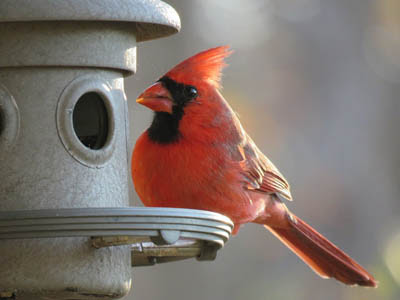 |
| Northern Cardinal. GeorgeB2 from Pixabay. |
Males of these large seed eaters are bright red with a black face and red crest.
Females replace most of the red with brown, The bill is large and orange.
These birds are found in woodlands, stream edges, residential areas.
Northern Cardinals are year-round residents in Florida.
American Robin
These are familiar lawn birds with red breasts.
 |
| American Robin. Greg Gillson. |
Male American Robins are brownish-gray above with a brick red breast. Females are paler orange below and paler gray above.
They are widespread in open country with scattered deciduous trees, residential areas.
American Robins are year-round residents in northern Florida, winter visitors throughout Florida.
House Finch
When people ask about a bird with a red head at their feeder, it is usually this bird.
 |
| Male House Finch. Greg Gillson. |
Males of this dusty brown striped finch have red limited to the head (specifically the forehead and eyebrow), breast (chest), and rump. The red coloration tends toward orangish, and may rarely be yellowish.
Females are streaked, similar to the males but without red. They lack any strong pattern on the face and head.
Note the small round head and curved upper ridge on the bill.
Some people call these red-headed sparrows. Sparrows and finches are similar, but in general, male finches are brighter than the females and tend to hang out more in trees. Sparrow genders are usually quite similar in coloration and tend to feed mostly on the ground.
These birds are common in residential areas, especially at bird feeders. In the West more widespread in arid regions near water.
House Finches are year-round residents in the northern half of Florida.
Ruby-throated Hummingbird
These red-throated birds are the only hummingbird nesting in the eastern United States.
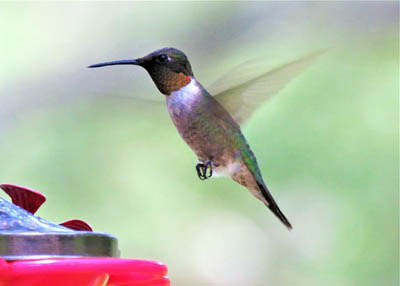 |
| Male Ruby-throated Hummingbird. GeorgeB2. Pixabay. |
Males are dark green above and on the belly. They have a white upper chest. The throat is ruby-red.
Females are green above, white below, including white throat.
These birds are found in woodland edges, residential yards. Readily come to hummingbird feeders.
Ruby-throated Hummingbirds are year-round residents throughout most of Florida, winter visitors only in far southern Florida.
Reddish Egret
These large egrets with red necks are hyperactive fish hunters.
These large herons come in white and dark color phases. Gray birds have cinnamon-red head and neck.
White birds are very similar to Great Egrets. All white. Bill is black in winter, but pink-based in breeding plumage. Easily told by constant running and flapping while wading.
They are found in salt marshes and shallow salt bays.
Reddish Egrets are year-round residents in coastal southern Florida.
Summer Tanager
These bright red birds are found toward the tops of tall trees in the southern United States.

Males are rose red with fairly heavy bill.
Females are yellowish or mustard-colored, some with a faint reddish wash.
In the East these birds are found in pine-oak woodlands. In the West they prefer tall cottonwood trees.
Summer Tanagers are summer residents in the northern half of Florida, winter visitors in the southern part of Florida.
Red-headed Woodpecker
These well-known woodpeckers with red heads have a fitting name.
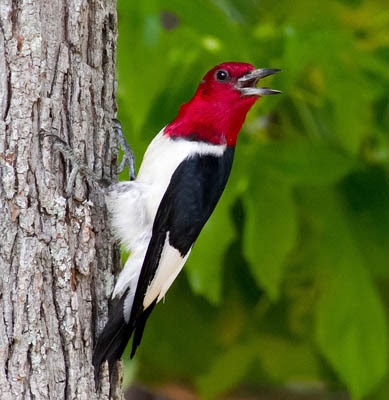 |
| Red-headed Woodpecker. Public domain. |
These birds have the entire head bright deep red. Back and tail black. Underparts white, as are inner secondaries and rump.
They are found in a variety of wooded habitats. They prefer to have oak and beech trees available. Sometimes come to feeders in winter.
Red-headed Woodpeckers are year-round residents in most of Florida. Rare in southernmost Florida.
Orange birds of Florida
True orange-colored birds are not that common. Many birds that I have here are paler rusty.
The common pattern is an orange body and black or brown wings and tail. Another common pattern is for the orange to be restricted to the under parts.
The following are orange birds that you are most likely to see in Florida.
Eastern Towhee
These birds with rusty-orange sides like to hide in dense bushes.
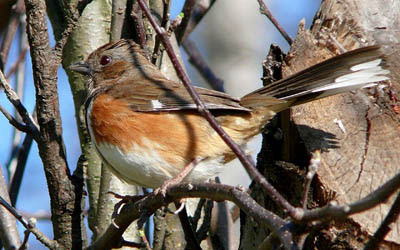 |
| Female Eastern Towhee. Skeeze. Pixabay. |
Males are black above with white wing patch, white tail corners. The sides are rusty. The belly white. Eyes variable: brown, red, orange, white, tending toward whiter southward.
Females are similar, but upper parts brown.
These birds are found in forest understory, dense brush, backyard hedges. Come to feeders.
Eastern Towhees are year-round residents throughout Florida.
Barn Swallow
These orange-bellied birds are a familiar sight across North America in summer.
 |
| Barn Swallow. Greg Gillson. |
These birds are purple-blue above with orange under parts and long forked tails. The color of the underparts in winter or on females are often cinnamon or buff-colored, but breeding males can be brighter orange-red.
These birds swoop low over fields and wetlands at lower elevations. They may build their mud nests in rafters on porches, garages, or other out-buildings.
Barn Swallows are summer residents throughout most of Florida.
American Redstart
In flight these small warblers flash orange or yellow in the wing and based of the tail.
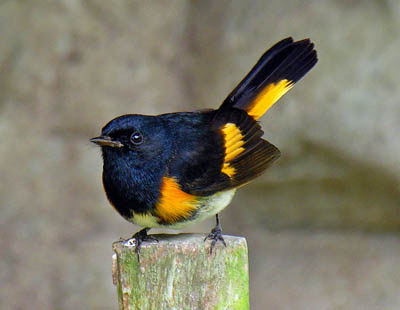 |
| American Redstart. Dennis Jarvis. Flikr. CC BY-SA 2.0 |
Males are black above, white on the belly. They have bright orange patches on side of breast, wings, and base of the tail.
Females are grayer, especially on the head/ The orange of males is replaced by yellow on the females.
These birds are found in regenerating woods after a clear cut, and willow tangles along streams.
American Redstarts are common spring and fall migrants throughout Florida, winter visitors in southernmost Florida.
Brown Thrasher
These are rather large rusty-orange songbirds.
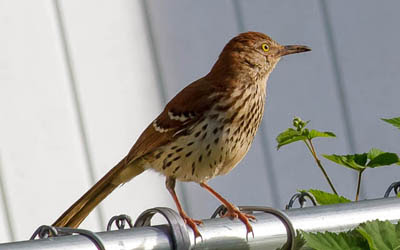 |
| Brown Thrasher. Linda Jones CC0. |
The upper parts of these birds is colored rusty-brown to orange. They show two white wing bars. Under parts are buff with heavy reddish-brown streaking.
These birds live in woodland edges and mature backyard landscaping.
Brown Thrashers are year-round residents throughout Florida.
Red-shouldered Hawk
Okay, the shoulders are reddish. But the rusty-orange breast and wing linings are barred red too.
 |
| Red-shouldered Hawk. Greg Gillson. |
The upper parts are barred black and white. The tail is banded black and white. In adults the breast is barred orange.
Immature birds are streaked with brown on the breast.
These birds like woodland edges, residential edges, riparian groves.
Red-shouldered Hawks are year-round residents throughout Florida.
American Kestrel
These are the familiar small rusty-orange falcons sitting on power lines on the edge of the highway, or hunting and hovering over the median strip.
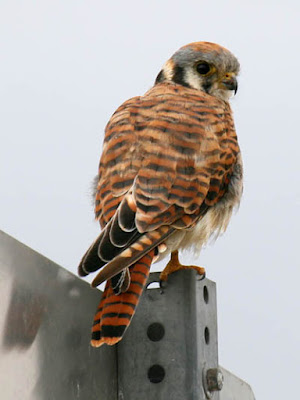 |
| Female American Kestrel. Greg Gillson. |
Females are rusty orange barred with black on their back wings and tail. The under parts are buff with black spots. The head shows two facial stripes.
Males have blue-gray backs and rufous tail is unmarked except for black tail band.
These birds are found in open country, farms, pastures with perches.
American Kestrels are year-round residents throughout Florida.
Yellow birds of Florida
Yellow is a common bird color! Often it is mixed with black and white plumage in birds.
Many birds with darker upper parts have yellow breast or belly.
The following are yellow birds you are most likely to see in Florida.
Yellow-rumped Warbler
These are abundant warblers across North America. Affectionately called “butter butts” by many birders, because of their bright yellow rumps that flash in flight.
 |
| Winter Yellow-rumped Warbler. Greg Gillson. |
Western form (Audubon’s) with bright yellow throat and yellow rump. Large white wing patch.
Northern and Eastern form (Myrtle) with white throat, yellow rump, and two white wing bars.
Winter birds are dull gray brown, with bright yellow rump. Throat may be cream colored or white. Often difficult to tell the two forms apart in winter.
Breed in mountain or boreal conifers. Widespread in migration. Winter in low river bottoms, open weedy deciduous areas. Rarely come to feeders in winter.
Yellow-rumped Warblers are winter visitors throughout Florida.
Common Yellowthroat
These buttery yellow birds are abundant in the marsh vegetation.
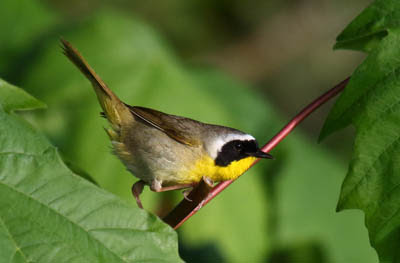 |
| Male Common Yellowthroat. Greg Gillson. |
These skulkers have bright yellow throats and yellow undertail coverts. Males have a black domino mask edged broadly in white, which females lack. Upperparts are dull olive-green.
Immature males in fall show a shadowed black mask.
Found in damp situations and heavy deciduous brambles following clear cuts.
Common Yellowthroats are year-round residents throughout Florida.
Great Crested Flycatcher
These flycatchers have long tails and big heads with big bill and bright yellow belly.
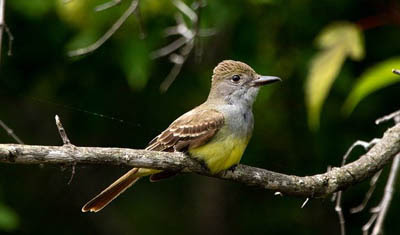 |
| Great Crested Flycatcher. Simard Francois. Pixabay. |
These birds are gray on the face and breast, brownish on rest of upper parts. Bright lemon yellow belly. The under side of the tail and some feathers of the wing are cinnamon colored.
These birds stay in the canopy of open woods.
Great Crested Flycatchers are summer residents throughout Florida, year-round residents in southernmost Florida.
Prairie Warbler
These birds with the yellow breasts and odd black line under the eyes are a resident of mangrove swamps.
 |
| Prairie Warbler. Public domain. |
Males are olive-green on the crown and back with chestnut streaks. Greenish-gray wings have pale wing bars. Yellow face and under parts. Yellow eyebrow, patch under eye. Black line through eye and below yellow under eye patch. Black streaks on sides.
Females are similar but facial pattern fainter, replaces black with green.
They are found in open scrubby woods, mangrove swamps.
Prairie Warblers are year-round residents in coastal southern Florida, summer residents only in the Florida Panhandle, and winter visitors in the interior of Florida.
Yellow-throated Warbler
These birds with the bright yellow throats creep along the branches high in trees.
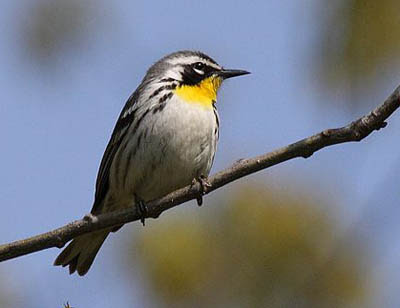 |
| Yellow-throated Warbler. Dominic Sherony. CC 2.0 |
These are rather gray warblers with bright yellow throat and upper breast. Black crown and face mask with white patch behind. White eyebrow. Two broad white wing bars. Black streaks on white breast and belly.
They like pine-oak woodlands, sycamores, cypress.
They are year-round residents throughout most of northern Florida, winter visitors only in southernmost Florida.
American Goldfinch
These small little birds are bright yellow and black.
 |
| American Goldfinch. Greg Gillson. |
Males are bright lemon yellow with black and white wings and tail, black cap. White under tail coverts. Pink bill.
Females are duller yellow below and brownish above. Lack black cap.
Winter birds are pale brown or gray, a touch of yellow on the throat of males.
These are birds of open country, fields with saplings, clear cuts, residential areas. They avoid dense forests, mountains, deserts. They visit feeders.
American Goldfinches are winter visitors throughout Florida.
Northern Flicker
These woodpeckers spend much time eating ants on the ground.
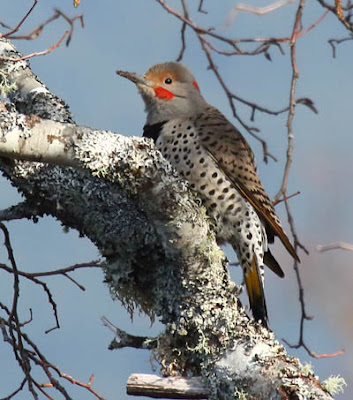 |
| Northern Flicker. Greg Gillson. |
These birds are larger than robins with brown and black barred upper parts. The underparts are pink with round black spots. There is a black crescent across the chest. When they fly away from you they reveal a large white rump.
Western birds have salmon-red under wings and under tail. Those in the East are colored yellow. The male face differs between the two populations–black whisker on the eastern birds, red whisker on western birds. Intergrades from overlap on Great Plains common. These may show male facial characteristics of both populations, or yellow-orange flight feathers.
These birds live in open woods with bare ground for foraging, residential yards.
Northern Flickers are year-round residents throughout Florida.
Eastern Meadowlark
These pale brown birds with the brilliant yellow breasts are home on the ground in prairies. They sing from perches on isolated trees, power poles, fence posts.
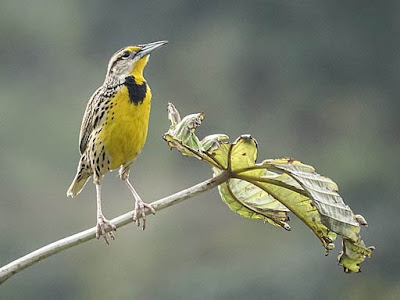 |
|
Eastern Meadowlark
Photo by Mike’s Birds from Riverside, CA, US [CC BY-SA 2.0]
|
The upper parts are streaked black, white, brown, so they blend into the dried grass where they live. The under parts are bright yellow with a black necklace across the chest. Very similar to Western Meadowlark, best told apart by spring song.
These birds live in prairies and extensive pasture lands.
Eastern Meadowlarks are year-round residents throughout Florida.
Cedar Waxwing
These crested birds with yellow band on the end of the tail are often found in flocks. They eat flying insects in summer, fruit and berries the rest of the year.
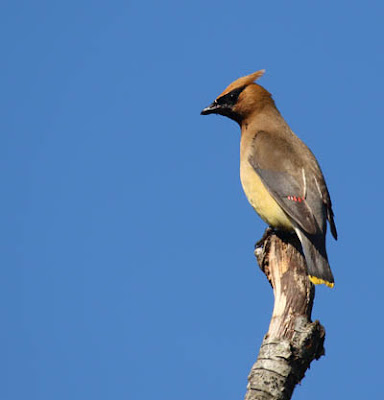 |
| Cedar Waxwing. Greg Gillson. |
These birds are fawn-brown above, with dark gray wings and tail. They have a black mask and wispy crest. The belly is yellow. The wings have waxy red drops on the end of the tertials. The end of the tail has a brilliant yellow tail band.
They are found in open habitats with berries, including juniper woodlands and towns in winter.
Cedar Waxwings are winter visitors throughout Florida.
Wrapping Up
Florida’s subtropical climate and diverse habitats give rise to a dazzling array of feathered gems. Here are some of the most captivating ones that are blues and greens.
Great Blue Heron: This stately wading bird with long legs and a piercing blue-gray plumage graces wetlands and shorelines, often spearing fish with their sharp beaks.
Eastern Bluebird: These sky-blue beauties with orange chests add a cheerful spark to open fields and woodlands. Their melodious songs complete the charming package.
Indigo Bunting: The male’s vibrant blue body and black bib create a stunning contrast, especially in sunlight. The female is a more subtle but equally beautiful mix of brown and blue.
Little Blue Heron: These smaller herons with blue-gray plumage and dagger-like bills patiently hunt for prey in shallow wetlands. Their white throat patch and wing stripes add a touch of elegance.
Blue-headed Vireo: These olive-green songbirds with bright blue heads and white spectacles stand out in dense foliage. Listen for their loud, musical songs.
Painted Bunting: This stunning resident boasts vibrant green, blue, and red plumage in males, while females and young males sport a solid green coat. Look for them in shrubby areas and woodlands.

Green Heron: These stocky waders with iridescent green backs and reddish legs hunt insects and small fish in marshes and swamps. Their distinctive “squawk” call is an easy giveaway.
Yellow-throated Warbler: This energetic little bird with a bright yellow throat and olive-green upperparts adds a sunshine spark to gardens and woodlands throughout the year.
Limpkin: This chestnut-brown bird with white spots and a curved beak resembles a heron but has a unique call and hunts snails in freshwater marshes.
Merlin: This small falcon with slate-blue upperparts and rusty underparts is a fierce predator, often chasing smaller birds for prey.
Frequently Asked Questions
What kind of bird has yellow eyes in Florida?
The American Oystercatcher’s bright yellow eyes, surrounded by a characteristic orange ring, play a crucial role in its life as a skilled shoreline forager:
- Acute color sensitivity: The yellow pigment in their irises helps filter out blue light, making them sensitive to red and orange hues. This is particularly helpful for spotting bivalves like oysters and mussels, which often have reddish or orange shells amidst the browns and greens of the shoreline.
- High-contrast vision: The stark contrast between the yellow eyes and the dark orange orbital ring further enhances their ability to detect edges and details, critical for pinpointing prey hidden among rocks and seaweed.
- Polarization sensitivity: Like many birds, American Oystercatchers can detect polarized light, which helps them see through glare and reflections on the water’s surface, giving them a clearer view of hidden prey below.

What is the white bird in Florida with an orange bill?
Finding the American White Ibis in Florida is a delightful birding adventure, as these elegant white waders grace many different habitats throughout the state. Here are some tips to guide your search:
Preferred Habitats:
- Coastal areas: American White Ibis are most commonly found in shallow coastal waters like saltwater marshes, tidal flats, and mangrove swamps. They wade in the shallows, probing the mud with their long beaks to catch fish, shrimp, and small crustaceans.
- Inland wetlands: During periods of lower water levels, American White Ibis venture further inland, visiting freshwater marshes, lakes, ponds, and even flooded fields to forage. They readily adapt to different food sources depending on the location and season.
- Man-made environments: These adaptable birds have become increasingly comfortable in human-made environments. Look for them in golf course ponds, wastewater treatment facilities, and even urban parks with suitable water features.
Are there red winged blackbirds in Florida?
Absolutely! Red-winged blackbirds are not only present in Florida, but they are also extremely common throughout the state.
Here’s why you’re likely to encounter these striking birds in Florida:
- Habitat: Red-winged blackbirds thrive in diverse habitats, including marshes, wetlands, fields, freshwater and saltwater marshes, swamps, and even backyards with water features. Florida’s abundance of such areas provides them with ample breeding grounds and foraging opportunities.
- Abundance: They are considered one of the most common birds in North America, and Florida is no exception. Their adaptable nature and prolific breeding success contribute to their high numbers.
- Year-round residents: While some populations migrate north for the summer, many red-winged blackbirds in Florida are permanent residents, ensuring you can see them throughout the year.
Related:
See photos and learn about the most common backyard birds in Florida, regardless of color.
See photos and learn what to feed winter birds in Florida.
Discover the different Feeder Birds in Florida, including videos!
Here’s a quick tutorial of how I would teach you to identify birds: 7 Steps to Identify Birds!
Birds with red heads in North America.
Yellow-and-black birds in North America.











